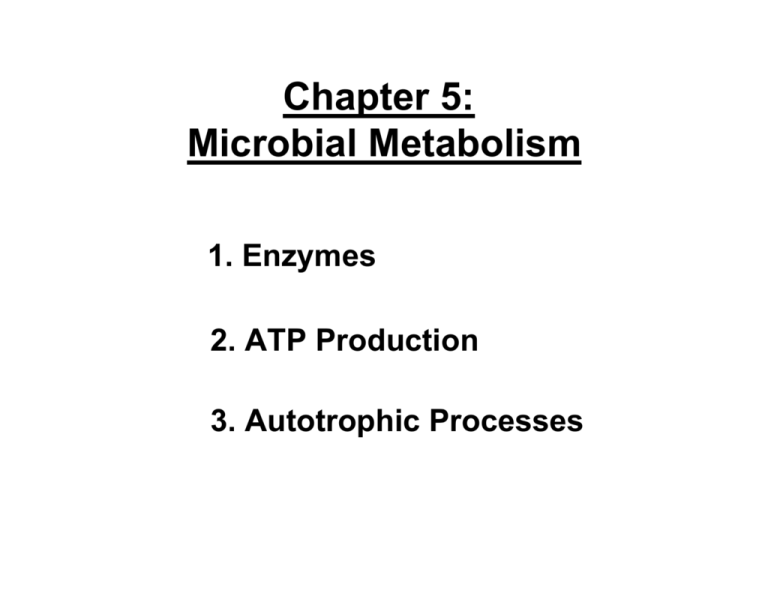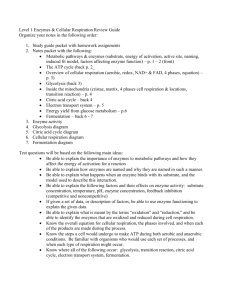Chapter 5: Microbial Metabolism
advertisement

Chapter 5: Microbial Metabolism 1. Enzymes 2. ATP Production 3. Autotrophic Processes 1. Enzymes Biochemical Reactions All living cells depend on biochemical reactions to maintain homeostasis. All of the biochemical reactions in an organism are collectively referred to as metabolism, which is of 2 basic types: catabolic: reactions that “break down” molecules • generally energy releasing or exergonic anabolic: reactions that build new molecules • generally energy requiring or endergonic **exergonic reactions provide energy for endergonic ones!** endergonic exergonic All organisms, prokaryotic or eukaryotic, need to build the molecules they need, and find the energy to do so! Metabolic Pathways Most biochemical reactions are part of a series of reactions referred to as a metabolic pathway: • it usu. takes multiple reactions to make “end-product” • pathways can be catabolic or anabolic • each reaction is catalyzed by its own enzyme Enzyme Basics Almost all biochemical reactions are catalyzed by a specific enzyme: • proteins that accelerate the rate of a reaction without being changed themselves • lower the activation energy (Ea) • the need for enzymes provides a way to control or regulate biochemical reactions • reactions won’t occur unless the enzyme that catalyzes the reaction is present & active Enzymes lower the Activation Energy **reactions won’t occur unless the Ea requirement is met** Enzymes physically bind Substrates Control of Enzyme Activity Biochemical reactions can be controlled by changes in enzyme activity, which can be influenced in several ways: 1) Changes in the amount of enzyme or substrate • more enzyme &/or more substrate = more product! 2) Changes in temperature, pH or [salt] • can effect enzyme structure, hence its activity 3) Availability of any necessary cofactors • some enzymes don’t work w/o a non-protein cofactor 4) Effect of inhibitors • molecules that bind to enzymes & reduce their activity Factors effecting Enzyme Activity Temperature pH [Substrate] • reactions occur more rapidly as temperature rises • enzyme structure depends on pH • reactions occur more rapidly as [substrate] rises **as long as enzyme is active (heat can denature enzymes) **pH affects charge of “R groups”, protein structure **saturation occurs when [substrate] is high enough Enzyme Denaturation • enzymes are polypeptides that retain their ability to function only when folded properly • changes in temperature, pH or [salt] can disrupt amino acid “R group” interactions causing the protein to unfold, i.e. become denatured **mutations can also lead to misfolded, non-functional enzymes** Some Enzymes Require Cofactors • can be a metal ion, vitamin, or other “non-protein” • if the cofactor is organic, it is called a coenzyme • enzyme is inactive w/o cofactor Enzyme Inhibition • inhibitors bind enzymes in 1 of 2 ways: • competitive inhibition (binding to active site) • allosteric inhibition (binding elsewhere, changing shape) • inhibitors can bind reversibly (can “come off”) or irreversibly (don’t come off, e.g. “poisons”) Feedback Inhibition The end-products of metabolic pathways are important reversible enzyme inhibitors • inhibit 1st enzyme in pathway, turning the pathway “off” low [inhibitor] = pathway ON high [inhibitor] = pathway OFF • can be competitive or allosteric inhibition • provide an important way of regulating end-product levels 2. ATP Production Adenosine Triphosphate (ATP) Preferred source of useable energy for ALL cells: • breaking bond of 3rd phosphate releases ideal amt of energy • bond is easily broken (low Ea) **This is why organisms convert “food” energy to “ATP” energy** How is ATP produced? In most organisms, energy from a “food source” is converted to energy in ATP by glycolysis followed by 1 of 2 processes: FERMENTATION (low ATP yield) or RESPIRATION (high ATP yield) Glycolysis Don’t memorize this!! Glycolysis is a catabolic pathway by which sugars such as glucose (& several other “food” sources) are broken down to two 3-Carbon molecules of pyruvic acid (or pyruvate): • releases energy to yield 2 ATP per glucose • also transfers high energy electrons (+ H) to NAD+ to yield 2 NADH Oxidation/Reduction Much of the energy in “food” molecules such as glucose is captured as high energy electrons (e-) by electron carriers such as NADH & FADH2 • when a molecule receives or gains electrons it is said to be reduced **e- are typically transferred as part of a Hydrogen atom** NAD+ NADH • a molecule that gives up electrons (i.e., loses H) is said to be oxidized Fermentation ATP production begins & ends with glycolysis in organisms that ferment. Fermentation is all about recycling NAD+ so that glycolysis can continue: NAD+ glycolysis fermentation NADH • NADH is oxidized to NAD+ by reducing pyruvate to lactic acid for example Different Fermentation Products * Different organisms recycle NAD+ in different ways, resulting in a variety of fermentation end-products. Respiration After glycolysis, energy in pyruvate & NADH is used to produce much more ATP by respiration: KREBS CYCLE • breaks down pyruvate to 3 CO2, energy captured as e- by NADH & FADH2 ELECTRON TRANSPORT • e- from NADH, FADH2 used to produce H+ gradient CHEMIOSMOSIS • H+ gradient used to make ATP The Krebs cycle • a cyclical metabolic pathway catalyzed by enzymes in the matrix of mitochondria • requires 2-C acetyl groups connected to coenzyme A (acetyl-CoA) (3-C) pyruvate + CoA (2-C) acetyl-CoA + CO2 (Krebs cycle) Electron Transport & Chemiosmosis Occurs in the mitochondria of eukaryotes and at the plasma membrane of prokaryotes. • oxygen (O2) is usually the final electron acceptor, but other molecules can play this role in anaerobic respiration Lipid & Protein Catabolism Lipids and proteins can also be used as sources of energy to produce ATP • different amino acids enter glycolysis or the Krebs cycle at various stages • fatty acids are broken down to acetyl groups & fed into the Krebs cycle Summary of ATP Production Obligate anaerobes: • fermentation or anaerobic respiration Obligate aerobes: • aerobic respiration (& brief periods of fermentation) Facultative anaerobes: • can survive via aerobic respiration OR fermentation 3. Autotrophic Processes All organisms depend on Autotrophs Autotrophs can produce organic molecules from CO2, an inorganic carbon source. • all heterotrophs require an organic source of carbon • organic molecules, directly or indirectly, come from autotrophs The source of energy for autotrophic processes can be: LIGHT: photoautotrophs that carry out photosynthesis CHEMICAL: chemoautotrophs that use various molecules as a source of high energy e- Light Reactions of Photosynthesis Electrons (from H2O) energized by sunlight: • fuel the synthesis of ATP through electron transport & chemiosmosis (much like respiration) • ultimately reduce NADP+ to NADPH • ATP & NADPH provide energy to fuel production of sugars in the “dark” reactions “Dark” Reactions Involves an anabolic pathway known as the Calvin-Benson cycle: • endergonic reactions of this pathway are fueled by ATP & NADPH from the “light” reactions Don’t memorize this!! • resulting sugars can be used as a source of energy or to build other organic molecules Summary of Energy Metabolism Key Terms for Chapter 5 • catabolic, anabolic; exergonic, endergonic • activation energy, substrate, active site • cofactor vs coenzyme, denatured • feedback inhibition: competitive vs allosteric • glycolysis, fermentation, respiration • Krebs cycle, electron transport, chemiosmosis • oxidation vs reduction • Calvin-Benson cycle Relevant Chapter Questions rvw: 1-7, 18, 20-22 MC: 1, 4-10





